Schedule
Watermelon Crop Schedule
| Product Name | Fertilizers | |||||
|---|---|---|---|---|---|---|
| Poornima Kit | NPK Grow Caps |
Humigrow Nano Powder |
Alp | Sonha-Bihan | ||
| Humic Acid | Chelated Multi-micronutrient |
PGP/PGR | ||||
| Soil Treatment | week -1 | |||||
| Sowing | week 0 | |||||
| Germination | week 1 | 1 Kit | ||||
| Vegetative Growth | week 2 | |||||
| week 3 | ||||||
| week 4 | ||||||
| week 5 | 2 Caps | 120 gm | ||||
| week 6 | ||||||
| week 7 | 250gm | 250gm | ||||
| week 8 | ||||||
| week 9 | 2 Caps | 120 gm | ||||
| week 10 | ||||||
| week 11 | ||||||
| week 12 | ||||||
| Harvesting | ||||||
| Total Quantity | 1 Kit | 4 Caps | 240gm | 250gm | 250gm | |
| Spray / Soil Application | |
| Top Dressing | |
| Soil Application | |
| Spray | |
| * | Optional |
NOTE: For the first year donot immidietaly substitute 100% chemical fertilizer with the SIESTO GREEN products, as the soil is used to chemical fertilizer, it may affect the output. So the best way to substitute is by reducing 50% of chemical input in the first year, 25% the following 2nd year, & then another 10% by the 3rd year. After the 3rd year use synthetic fertilizer / inorganic fertilizer if their is a requirement depending on the soil health.
CROP SCHEDULE FOR WHEAT
Sr. No.Treatment / ApplicationProductDose /AcreAPPLICATIONManagement1Vegetative – Dissolve in 20 to 200 ltr. of water as required for 1 acre of land and apply through Drip Irrigation or drench.POORNIMA KIT1 KITApply it 1 week afterIt is a balanced form of nutrients that includes NPK, Zinc, Cropforce NP, Humigrow NP, and Mycorrhiza NP.2Vegetative – Mix all with the required amount of water and apply through drip irrigation, flood irrigation, or drenching as per farmer’s availability.NPK + Humigrow2 Caps + 120gmApply it in week 5,9It is a balanced form of Nutrition that includes NPK.3Flowering/ Fruiting – Mix both in 20 – 200 liters of water as per requirement and apply it to the soil, or spray on the plants.ALP + Sonhabihan250gm + 250gmApply it in week 7It is a Micronutrient and PGP that helps in Growth, Fruit set, and the quality of the produce.
NOTE: For any kind of Deficiency, Pest attacks, or Fungal or Bacterial diseases use the products as suggested.
GENERAL PEST ATTACKS, BACTERIAL, OR FUNGAL MANAGEMENT
PEST / BACTERIAL / FUNGAL
IDENTIFICATION IN CROP
SYMPTOMS
SUGGESTED PRODUCT
Fusarium wilt
 The first symptom appears as chlorosis of the leaves. Wilting of leaves from bottom to top occurs.
Bacillus + Indofa + Lifeline
Alternaria Leaf spot
The first symptom appears as chlorosis of the leaves. Wilting of leaves from bottom to top occurs.
Bacillus + Indofa + Lifeline
Alternaria Leaf spot
 Small, round to irregular spots with a grey center and dark margin on leaves. Spots usually start on lower leaves and gradually advance upwards.
Indofa
Downy mildew
Small, round to irregular spots with a grey center and dark margin on leaves. Spots usually start on lower leaves and gradually advance upwards.
Indofa
Downy mildew
 Yellow, angular spots restricted by veins resembling mosaic mottling appear on the upper surface of leaves.
Lifeline + Indofa + BT + Bacillus
Powdery Mildew
Yellow, angular spots restricted by veins resembling mosaic mottling appear on the upper surface of leaves.
Lifeline + Indofa + BT + Bacillus
Powdery Mildew
 Whitish powdery growth on upper foliage stems, and young growing parts. The superficial growth ultimately covers the entire leaf area.
Lifeline + Indofa + BT + Bacillus
Anthracnose
Whitish powdery growth on upper foliage stems, and young growing parts. The superficial growth ultimately covers the entire leaf area.
Lifeline + Indofa + BT + Bacillus
Anthracnose
 Water-soaked lesions are seen on the leaf which later become yellowish irregular spots.
Indofa + Bacillus
Aphid
Water-soaked lesions are seen on the leaf which later become yellowish irregular spots.
Indofa + Bacillus
Aphid
 Infesting tender shoots and under the surface of the leaves.
Lifeline + Traps + Meta + BT
Leaf Miner
Infesting tender shoots and under the surface of the leaves.
Lifeline + Traps + Meta + BT
Leaf Miner
 Leaves with silvery serpentine mines. Drying and dropping of pre-matured leaves in severe cases.
Lifeline + Traps + Meta + BT
Whitefly
Leaves with silvery serpentine mines. Drying and dropping of pre-matured leaves in severe cases.
Lifeline + Traps + Meta + BT
Whitefly
 Normal photosynthesis is restricted due to the growth of black sooty mold on the honeydew excreted by the whitefly.
Lifeline
Spider Mites
Normal photosynthesis is restricted due to the growth of black sooty mold on the honeydew excreted by the whitefly.
Lifeline
Spider Mites
 In severe infestations, leaves completely desiccate and drop off.
Lifeline + Traps + Meta + BT
Thrips
In severe infestations, leaves completely desiccate and drop off.
Lifeline + Traps + Meta + BT
Thrips
 They start feeding by rasping the leaf surface with their mouthparts to release the liquids from the plant cells and suck the plant juice.
Lifeline + Traps + Meta + BT
Leaf Eating Caterpillar
They start feeding by rasping the leaf surface with their mouthparts to release the liquids from the plant cells and suck the plant juice.
Lifeline + Traps + Meta + BT
Leaf Eating Caterpillar
 It can also feed on the ovaries of flowers; sometimes bore into young developing fruits.
BT + Meta
Root-knot nematode
It can also feed on the ovaries of flowers; sometimes bore into young developing fruits.
BT + Meta
Root-knot nematode
 The formation of galls on the host root system is the primary symptom.
Meta + BT + Pacliq
The formation of galls on the host root system is the primary symptom.
Meta + BT + Pacliq
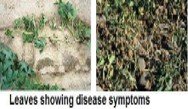 The first symptom appears as chlorosis of the leaves. Wilting of leaves from bottom to top occurs.
Bacillus + Indofa + Lifeline
Alternaria Leaf spot
The first symptom appears as chlorosis of the leaves. Wilting of leaves from bottom to top occurs.
Bacillus + Indofa + Lifeline
Alternaria Leaf spot
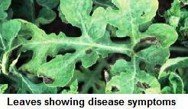 Small, round to irregular spots with a grey center and dark margin on leaves. Spots usually start on lower leaves and gradually advance upwards.
Indofa
Downy mildew
Small, round to irregular spots with a grey center and dark margin on leaves. Spots usually start on lower leaves and gradually advance upwards.
Indofa
Downy mildew
 Yellow, angular spots restricted by veins resembling mosaic mottling appear on the upper surface of leaves.
Lifeline + Indofa + BT + Bacillus
Powdery Mildew
Yellow, angular spots restricted by veins resembling mosaic mottling appear on the upper surface of leaves.
Lifeline + Indofa + BT + Bacillus
Powdery Mildew
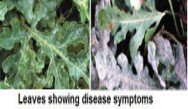 Whitish powdery growth on upper foliage stems, and young growing parts. The superficial growth ultimately covers the entire leaf area.
Lifeline + Indofa + BT + Bacillus
Anthracnose
Whitish powdery growth on upper foliage stems, and young growing parts. The superficial growth ultimately covers the entire leaf area.
Lifeline + Indofa + BT + Bacillus
Anthracnose
 Water-soaked lesions are seen on the leaf which later become yellowish irregular spots.
Indofa + Bacillus
Aphid
Water-soaked lesions are seen on the leaf which later become yellowish irregular spots.
Indofa + Bacillus
Aphid
 Infesting tender shoots and under the surface of the leaves.
Lifeline + Traps + Meta + BT
Leaf Miner
Infesting tender shoots and under the surface of the leaves.
Lifeline + Traps + Meta + BT
Leaf Miner
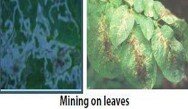 Leaves with silvery serpentine mines. Drying and dropping of pre-matured leaves in severe cases.
Lifeline + Traps + Meta + BT
Whitefly
Leaves with silvery serpentine mines. Drying and dropping of pre-matured leaves in severe cases.
Lifeline + Traps + Meta + BT
Whitefly
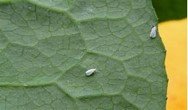 Normal photosynthesis is restricted due to the growth of black sooty mold on the honeydew excreted by the whitefly.
Lifeline
Spider Mites
Normal photosynthesis is restricted due to the growth of black sooty mold on the honeydew excreted by the whitefly.
Lifeline
Spider Mites
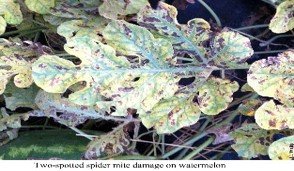 In severe infestations, leaves completely desiccate and drop off.
Lifeline + Traps + Meta + BT
Thrips
In severe infestations, leaves completely desiccate and drop off.
Lifeline + Traps + Meta + BT
Thrips
 They start feeding by rasping the leaf surface with their mouthparts to release the liquids from the plant cells and suck the plant juice.
Lifeline + Traps + Meta + BT
Leaf Eating Caterpillar
They start feeding by rasping the leaf surface with their mouthparts to release the liquids from the plant cells and suck the plant juice.
Lifeline + Traps + Meta + BT
Leaf Eating Caterpillar
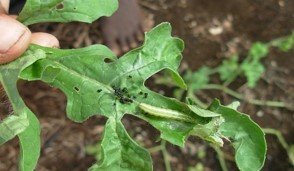 It can also feed on the ovaries of flowers; sometimes bore into young developing fruits.
BT + Meta
Root-knot nematode
It can also feed on the ovaries of flowers; sometimes bore into young developing fruits.
BT + Meta
Root-knot nematode
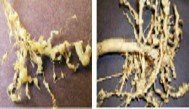 The formation of galls on the host root system is the primary symptom.
Meta + BT + Pacliq
The formation of galls on the host root system is the primary symptom.
Meta + BT + Pacliq


